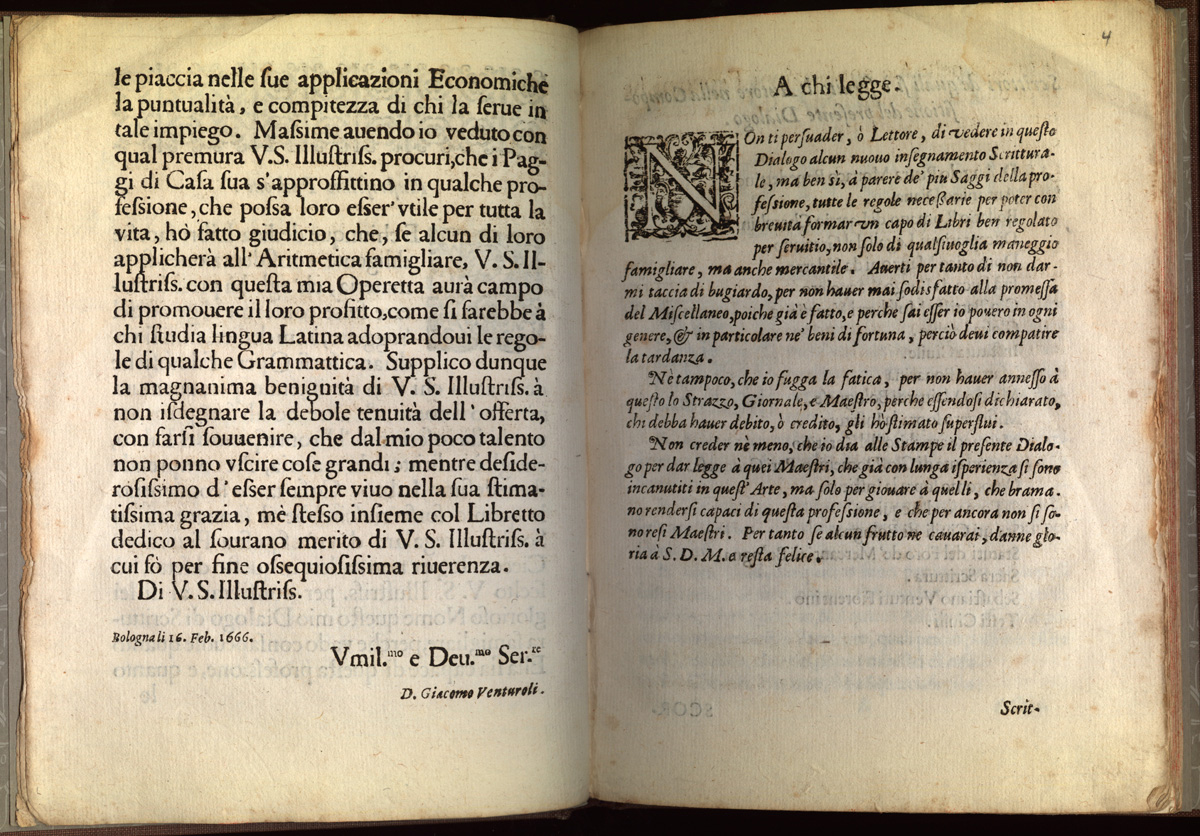6.07 Who's Learning Math?

Much the most interesting aspect of Venturoli's booklet is the way in which he identified his audience, for he gave a snapshot of the intended readers of vernacular self-help books at the end of our period. The title page announced that bookkeeping of the sort described here was specifically intended for householders, legal guardians, and administrators of guilds or societies. In a dedication to a Bolognese nobleman, Venturoli made it clear that his book was also an invitation to social mobility, suggesting that some of the servant boys in his patron's household might find the book a stepping stone to better employment later in life. An address to the reader followed, offering a pastiche of commonplaces: No one should take offense at what they fail to find here. This book is merely a simple introduction, not meant to replace more advanced books. It is intended only for beginners, not for those who have already mastered the subject. Apparently, Venturoli did not want to seem to be offering his book to pre-professional students of bookkeeping. On the other hand, to this almost abject introduction Venturoli appended a list of his sources, which range widely and ambitiously. He listed a few standard authors on bookkeeping (Pacioli and Manzoni) and others on commercial and domestic economy, but he also claimed greater weight for his work by citing the laws and statutes of Italian cities, a collection of papal bulls, the Code of Justinian with its learned glosses, St. Thomas Aquinas, and holy writ. At least in the popular market, then, it was not unseemly advertising to claim that bookkeeping had its place in a long tradition of high culture.
Manzoni's, Casanova's, and Venturoli's preoccupation with the formal qualities of the ledger reflected a general tendency throughout our period to see careful record keeping (and good, clear handwriting too) as part of honest commercial practice. Tagliente and others published manuals in several fields relating to record keeping -- reading, writing, and abaco. Manzoni went so far as to offer a reading and calligraphy manual as an elementary introduction to his books on accounting. (40) Readers of bookkeeping manuals were repeatedly warned to keep their records neatly and accurately and to avoid falling into the vice of "ill kept accounts" (scritture mal tenute) which would later have to be "re-ordered" (drizzate). These are moralistic terms. Indeed, scrupulous bookkeeping served to legitimate business as a vocation. The good record-keeper was not only a good businessman, he was also a virtuous Christian. This attitude persisted well into the eighteenth century. (41)

Bookkeeping usage was as important to merchants of the sixteenth century as classicizing grammar was to contemporary humanists. Venturoli made the analogy explicit, saying that "with this little work of mine [a student] will have the chance to improve himself, just as someone would who studies the Latin language making use of the rules in a grammar book." (42) One late edition, still published by Comin da Trino some forty years after the first, even included a substantial appendix of calligraphic specimens, which can only have been intended to suggest to the bookkeeper that he should cultivate good and careful script. (43) No surprise, then, that handwriting textbooks were published for the first time in just the years that saw the first bookkeeping manuals. And Giovanni Antonio Tagliente was on the spot.
NOTES
- Open Bibliography
- (40) Manzoni 1550, cited in De Blasi 1993, 392-393.
- (41) Davis 1960, 22; Tucci 1973, 367-371; Grendler 1989, 322-323; Carruthers and Nelson-Espeland 1991, 36-44; Jaffe 1999, 65-76; Ciocci 2003, 227-230.
- (42) Venturoli 1666, dedication: ...con questa mia Operetta avrà campo di promuovere il loro profitto, come si farebbe à chi studia lingua Latina adoprandovi le regole di qualche Grammatica.
- (43) Manzoni 1574.